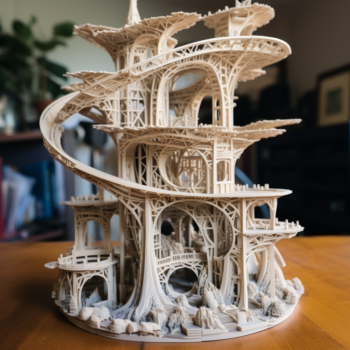Using PETG as a support material for PLA 3D prints can offer numerous advantages due to its distinct mechanical properties and good compatibility. To create a successful 3D print using PETG as support material for PLA, you’ll need to follow these steps:
Read more: PETG as Support Material for PLA Prints1. Understanding the Materials
- PLA (Polylactic Acid): PLA is a popular 3D printing material known for its ease of use and good surface quality.
- PETG (Polyethylene Terephthalate Glycol): PETG is a more flexible and durable material than PLA, with higher temperature resistance.
2. Printer Setup
- Dual Extruder Requirement: To print with PLA and PETG simultaneously, your 3D printer must have a dual extruder setup. This allows you to print with two different materials in the same print job. The only other option is to use a printer like the BambuLab X1C with the AMS-Module that can use up to 16 colors for one print-head.
- Nozzle Temperature: Set the nozzle temperature suitable for both materials. PLA typically prints at around 180-220°C, while PETG requires a bit higher temperature, around 230-250°C.
- Bed Temperature: The bed temperature should be set to accommodate both materials, usually around 70-80°C.
3. Design Considerations
- Support Structures: Design support structures that are easily removable. PETG’s slightly higher flexibility compared to PLA can be advantageous here.
- Interface Layers: Consider adding a few interface layers between the PLA and PETG to enhance separation after printing.
4. Slicer Settings
- Use a Compatible Slicer: Ensure your slicer software supports dual extrusion and can handle both PLA and PETG.
- Support Settings: Adjust your support settings for PETG, considering factors like support density and pattern.
- Print Speed: PETG often benefits from a slower print speed than PLA, so adjust your settings accordingly.
5. Printing Process
- Monitor the First Few Layers: Watch the first few layers closely to ensure good adhesion and proper material deposition.
- Avoid Warping: Ensure the print bed is level and the environment is stable to prevent warping or layer separation.
6. Post-Processing
- Removing Supports: PETG supports should come off relatively easily. Use tools like pliers or tweezers if necessary.
- Finishing Touches: Clean up any stringing or imperfections with a craft knife or fine sandpaper.
7. Troubleshooting
- Material Adhesion Issues: If the materials are not adhering well, adjust temperatures or consider using an adhesion promoter on the print bed.
- Oozing and Stringing: Fine-tune retraction settings for both materials to reduce oozing.
8. Best Practices and Tips
- Test Print: Always do a small test print to refine settings.
- Ventilation: Ensure good ventilation due to the fumes, especially when printing with PETG.
Conclusion
Using PETG as a support material for PLA in 3D printing can be highly effective, especially for complex models requiring sturdy support. By following these steps and continually experimenting with settings, you can achieve high-quality prints with clean overhangs and minimal post-processing work.
Remember, every printer and filament can behave differently, so be prepared for a bit of trial and error to get the best results.
